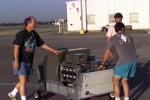
The Atmospheric Chemistry of Combustion Emissions Near the Tropopause (ACCENT) mission is an interagency mission to study the effects of rockets and aircraft in the upper troposphere and lower stratosphere. ACCENT is jointly sponsored by the Atmospheric Effects of Arcraft Program (AEAP) and the Rocket Impacts on Stratospheric Ozone (RISO) program (see some RISO highlights). As part of that mission, the NASA GSFC aircraft field missions group has been providing flight planning tools and meteorological support in real time for the mission project scientists.
Following are a few pictures of the September 1999 ACCENT deployment. We are using the WB-57F aircraft for carrying the ACCENT payload (See the USAF Museum page for WB-57F history). We are based at Ellington Field just outside of Houston, TX. Ellington Field is part of the Johnson Space Center. All of the Johnson aircraft are based here.
The WB-57F is based in Hangar 990 here at Ellington Field. Here we see the
WB-57F in front of Hangar 990 just prior to the overflight of hurrican
Floyd on September 15, 1999.

The ACCENT instrument and support people are housed in a small building just next to hangar 990 in Building 994. In the image above, building 994 is the small building between the WB-57F and the large hangar 990 in the background. Our group is from the NASA Goddard Space Flight Center . In particular, we work in the Atmospheric Chemistry and Dynamics Branch (Code 916).
Our workspace is a bit constricted in building 994. We have to squeeze 4
people on to these two small tables. Here we see Leslie Lait pounding away on
his laptop in preparation for the September 15 flight.

The all-hands meeting on September 16, 1999 met to discuss the flight
proposal for September 17 in the building 994 lab area. Obviously, the
facillities are fairly cramped. Here we see the project scientist Randy Friedl (center of the image)
discoursing on why Paul Newman deserves the Nobel Prize.

Kathy Wolfe (our project coordinator) smiles for the camera.

The meteorological team argues about the details of a flight plan for Costa
Rica. From right to left are Karen Rosenlof, Tom Kucsera, Rennie Selkirk (known
as Dr. Boogie), and Leslie Lait.

The WB-57F is the workhorse aircraft for ACCENT. The WB-57F is modified from
the Martin B-57 Canberra light bombers. The WB-57F is capable of carrying a
4000 lb. payload to altitudes over 60,000 ft, and with a range in excess of
2300 nautical miles. Here we see two other images of the WB-57F on September
15, 1999 just prior to takeoff.



There are a large number of instruments aboard the WB-57F for the fall ACCENT flight series.
Elliot Atlas of NCAR is seen here preparing the Whole Air Sample (WAS) for
the flight of September 15, 1999. The WAS instrument (located in the bottom
left corner of the image) collects air samples in cans (the cylinders in the
rack).

Here we see the rollout of WAS (the cans in the rack on the right side of
the pallet), and the NCAR CH4 tunable diode laser (in the box-like enclosure on
the left side of the pallet). Elliot Atlas and Jim Hannigan are rolling
the pallet out, while Dave Thomson watches in the background.

The instruments bolt up into the bombbays of the WB-57F. Here we see that
the pallet has been rolled under the wing, and Elliot Atlas, Jim Hannigan, the
WB-57F crew preparing to bolt the pallet into the bombbay. You can see that
the other forward pallets have already been bolted on.

Hurricane Floyd hit the US between September 14 and 16, 1999. We used the
WB-57F to sample the stratospheric outflow and thermal structure. The WB-57F
took off about 10AM CDT and returned about 3PM CDT. Pictured here we see a
cloud image of Floyd taken by Steven Padar in Sarasota, using a multispectral
image of 3 (yes three) spectral bands of HRPT. The image is valid at about the
same time that the WB-57F was over the hurricane eye.

The aircrew is going through the pre-flight.
The pilot for the flight was Scott Reagan (seated in front), while
the backseater was Drew Nash.


The instrument loading began at 5:30 AM CDT. Here we see a Clive
Midwinter loading the CPFM UV-Vis instrument on the tail of plane.

Shelley Hilden sits on the rim of the cockpit while Don Anderson (left)
and Adrian Tuck (right) supervise.

Ken Kelly and Zim Sherman check out a pressure leak in the frost point
hygrometer on the starboard wing pod.

An early morning loading of the port wing pod. From right to left are
Tim VanRekn, Andy Rutter, and Rick Flagan.

Pilot Rick Hull pauses during his pre-flight of the WB-57F.

Readying the WB-57F for the flight.

Other pictures of things at and near Ellington
Go to the available forecast plots? Yes.
Unless otherwise noted, the photographs were made by Dr. Paul A. Newman
Go up to Dr. Newman's website? Yes
Last Updated: 1999-09-17
Author: Dr. Paul A. Newman (NASA/GSFC, Code 916) (newman@notus.gsfc.nasa.gov)
Web Curator: Dr. Leslie R. Lait (Raytheon ITSS) (lrlait@ertel.gsfc.nasa.gov)
Responsible NASA organization/official: Dr. Paul A. Newman, Atmospheric Chemistry and Dynamics Branch